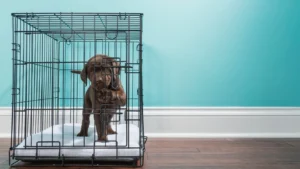Crate training is one of the most effective ways to provide your dog with a safe, comfortable space they can call their own. When done correctly, crate training supports potty training a puppy, helps manage dog separation anxiety, and fosters calm behaviour. At Bark Busters, our in-home dog training approach ensures crate training is personalized and positive, focusing on building trust and understanding between you and your dog.
Why Crate Training Matters
A properly introduced crate acts as a den-like space where your dog can relax, sleep, and feel secure. Crate training is not about confinement, it’s about giving your dog a predictable, comforting routine that aligns with their instincts.
Benefits of crate training include:
. Safety: A crate helps prevent destructive behaviours when you’re unable to supervise your dog, protecting both your home and your pet.
. House Training: Since dogs instinctively avoid soiling their sleeping area, crate training can significantly support the house training process, especially with puppies.
. Travel: Crates provide a safe way to transport your dog by car.
. Dog separation anxiety: A crate can help many dogs feel calmer when left alone.
How to Get Started with Crate Training
Every dog is unique, and introducing a crate should be a positive experience tailored to your dog’s temperament and needs. At Bark Busters, we understand that crate training can be overwhelming without the right guidance. That’s why our in-home dog trainers work with you and your dog to create a customized crate training plan that supports your dog’s well-being and helps prevent destructive chewing, anxiety, and other unwanted behaviours.
Our trainers use natural canine communication techniques, focusing on calm guidance and consistent routines that build trust and respect. We’ll help you:
. Choose the right crate size and setup
. Create a safe and inviting space for your dog
. Introduce the crate gradually in a way that your dog understands
. Use positive reinforcement to build a strong, lifelong association with the crate
With Bark Busters’ guidance, crate training becomes part of a comprehensive plan that fosters a happier, more balanced relationship between you and your dog.
Common Challenges in Crate Training
Whining or Barking in the Crate
It’s normal for dogs to protest at first. Stay calm and wait for a quiet moment before letting them out. If your dog continues barking, they may need more exercise or mental stimulation before crate time, or the crate has not been introduced properly yet.
Dog Separation Anxiety
Some dogs struggle with dog separation anxiety and may become distressed when crated. Our trainers can help develop a plan that builds confidence and teaches your dog that the crate is a safe space.
Aggressive Behaviour or Resource Guarding
Occasionally, a dog may show dog resource guarding behaviour, protecting the crate or items inside it. Bark Busters addresses these behaviours with you, to create a safe environment for both the dog and the owner.
Why Choose Bark Busters Canada?
At Bark Busters Canada, our in-home dog training is customized to your dog’s temperament and your family’s needs. Whether you’re working on training for puppies, managing aggressive dog training, or building confidence through crate training, we’re here to support you.
With over 250 trainers worldwide, Bark Busters brings personalized support to dog owners across the country. Our Life Of Dog guarantee means we’re committed to helping you achieve long-term success.
FAQs
Q: How long does crate training take?
A: Every dog is different. Some dogs adjust in just a few days, while others may take weeks. Our trainers work with you to build a plan that sets your dog up for success.
Q: Is crate training suitable for older dogs?
A: Absolutely. While crate training is often associated with puppies, older dogs can also benefit from having a safe space. Our trainers tailor the approach to your dog’s age and temperament.
Q: Can crate training help with house training a puppy?
A: Yes! Crate training aligns with a dog’s natural instinct to keep their sleeping area clean, making house training a puppy more effective.
Q: What if my dog hates a crate?
A: If it’s introduced properly, a crate can be a relaxing place for many dogs. We focus on making the crate a positive, calm space – it is never used for punishment. However, Bark Busters trainers know how to adjust for individual dogs and situations. Talk to your Bark Busters trainer if a crate is causing unnecessary stress.
Q: Does Bark Busters offer dog training near me?
A: With 20 trainers across Canada, we provide in-home dog training in many locations. Click our “Find A Trainer” button at the top of the page to find a trainer near you!





